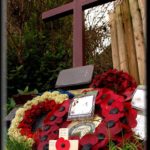Airspeed Oxford NM683, Rushup Edge, Peak District.
‹ Return to Air Crash Sites

Airspeed Oxford NM683, Rushup Edge, Peak District.
The first of two Airspeed Oxfords to crash in 1945 within a mile or so of each other, in similar circumstances, which resulted in both crews surviving.
4th March 1945. Pat Cunningham says Oxford NM683, crewed by very experienced airmen, was combining ferrying a passenger from RAF Warboys near Huntingdon to RNAS Stretton near Warrington with a navigational exercise. This was a routine flight and, with the war nearly over, probably something of a pleasure trip as well.
Cunningham suggests that pilot Flight Lieutenant Gipson, DFC and Bar, took the scenic route over the Peak District. Cloud cover began to form and luckily the pilot saw the steeply rising slope of Rushup Edge in front of him, and managed to pull back on the stick.
The aeroplane crashed flat on the hill and though injured, all on board survived. Luckier still, a fire didn’t break out, and locals afterwards were amazed at the sight; it looked as though the aircraft had landed on the steep hillside as if pinned like a butterfly.
Crew;
Flight Lieutenant Gipson, DFC and Bar
Flight Lieutenant Barclay, DFC
Flying Officer Skone-Rees, DFC
Flight Lieutenant Jones DFC
Details from Peakland Air Crashes – The North, P Cunningham, 2006.
One blog site doesn’t mention there being a passenger delivery job to complete and has Flight Lieutenant Jones listed as second pilot. That site also identifies Flight Lieutenant Barclay as Australian.
Site visit June 2020


EDIT 29 January 2024, please see additional comments below by the relatives of some of the crew.
10 comments on “Airspeed Oxford NM683, Rushup Edge, Peak District.”
Leave a Reply to P. Pickett. Cancel reply
Image Information
-
Full Size: 2304×3072px



I can understand this crash, having once been in a private light plane that nearly flew into a hillside. Those hillsides approach very fast at 100 plus mph !
I’m always amazed that there are still signs of these crashed aircraft 60 or 70 years on.
[http://www.flickr.com/photos/tony-hopkinson/]
Sounds like a cracking story Tony.
You get any photos or were you busy concentrating on the rapidly approaching hillside?!
I’m much the same about finding these traces, especially in popular areas like the High Peak. Lots of people visit the sites over the years, but when you think how many times we all must have passed by these places without the faintest idea of what’s just a few yards off the path, it is amazing.
That’s a good "lump" of Oxford that’s been left on the hillside, I have a couple of undercarriage panels from an Airspeed Oxford complete with serial number and yellow paint scheme, rescued from a scrapyard merchant near here. Quite a bargain for a fiver. The chap hadn’t a clue what they were and thought that I was the one who was nuts in buying them!!
Great shot Ian and as ever a facinating story – they were lucky to survive !
In 1941 an Oxford crashed between 2 houses in Laburnum Avenue, Kingston-upon-Hull East Yorkshire, after dark, 300 yds short of East Park. It was said the pupil pilot was in trouble & was trying to land in the park, there was no fire, both he & his instructor were killed
Great read.cheers
Great picture! Re your last sentence, F/L Douglas Jones was listed as the 2nd pilot according to flight accident investigation documentation. He was my uncle and I was always told he was catching a flight back to Warrington for some leave. I have read an account (by F/L Brian Gipson) that they may have arranged special navigational training flights so that people could be delivered for leave. He broke his back in this accident. Before that he was a Pathfinder pilot in 97 Sqdrn.
Thanks Andrew,
Ian
This was my father’s last flight. The story he always gave me was they would combine cross country exercises with giving a colleague a trip home. Not sure who the “lucky” one was on the crew list. His ankle was badly smashed between the throttle controls and he suffered cuts and bruises all over. Late 60’s his thumb developed paralysis. Xrays showed a foreign body in his hand. Surgery removed a small shard of bakelite thought to be from the control panel. Since his hands were protected by at least 2 pairs of gloves it was assumed the shard had entered his forearm and had gradually worked its way down to his hand.
Must check this location out one day before i am unable to.
Thanks John, interesting extra detail there.
Let me know if you need the grid reference for the crash site. It’s not too difficult to reach it.
Ian